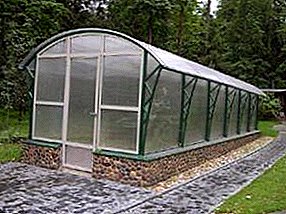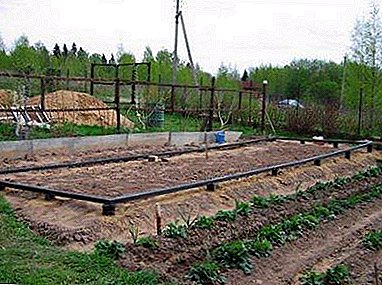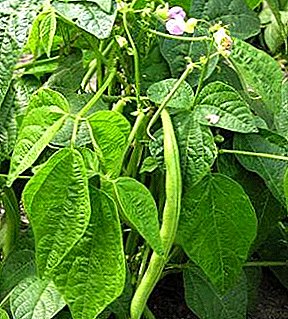
Many gardeners, deciding to build a greenhouse on the site, do not think about reliable basis for her. Of course, the greenhouse is not a capital structure and the load on the soil from it is small.
Therefore, many believe that a reliable foundation is needed only for capital garden buildings, and an ordinary light greenhouse can be placed directly on the ground.
Such a solution, among other things, makes the greenhouse mobile and allows you to move it to any convenient place. However, in most cases, the foundation, even for a light structure, is necessary, since it performs a number of extremely important functions.
What is the foundation for the greenhouse?
As for the greenhouse, built by hand, and for the industrial design basis will provide the stability and durability of the entire structure. Installation of a greenhouse should be taken care of in the following cases:
- When light greenhouse framewith high windage, must be securely fixedto prevent gusting;
- When the greenhouse has large size and weightto prevent deformation due to soil subsidence;
- When the greenhouse is built for year-round functioning and adjoins the residential house;

- When the foundation is supposed to be deepened below the freezing point and thus save on heatingby keeping the room warm;
- When the owner intends extend service life structures, insulating it from the external harmful effects of moisture and soil, for example, to prevent rotting of the wooden frame;
- When the foundation becomes an obstacle for the penetration of cold air currents near the ground and fogs;
- When there is a need in plant protection from rodents and harmful insects;
- When the installation site is not permanently protected and secured on a secure basis save from damage vandals.
Foundation types and recommendations for choosing the right solution
The foundation for the greenhouse should be selected based on its design features, the soil at the installation site. And also based on the possibility of acquiring those or other building materials. The experience of construction work with the owner of the site is also important.
Many are concerned about the question of whether it is possible to make a foundation for a greenhouse with your own hands? Yes, the owner can build simple bases with minimal skills. For example, such is the foundation for the foam block greenhouse.
- Dotted base is the simplest construction. In essence, it is a support for the construction of the greenhouse, allowing to put the frame horizontally, without deformation, and also to some extent protects against the effects of ground moisture.
 Point supports can be made from any available material, such as timber, bricks, concrete or foam concrete blocks.
Point supports can be made from any available material, such as timber, bricks, concrete or foam concrete blocks.
The higher the mass of the structure, the stronger the support material should be.
This type of base can be used when installing light temporary greenhouses, a long operation of which is not provided.
For example, when planting seedlings on open ground.
- The base for the greenhouse from a bar is a more complex structure. It is made in the form of a frame from a material suitable over the cross section.
This design can be placed both directly on the ground and recessed into the soil.
It is easy to attach the frame of any greenhouse to the wooden base.
The base of the greenhouse itself for reliability is usually attached to the posts dug into the ground at the corners of the structure.
Such a constructive solution will be optimal for the installation of a greenhouse with a light frame and covering material for one season when the owner of the site has the intention to change the location of the structure to achieve the greatest efficiency of agriculture.
A greenhouse with a wooden base can easily be moved with minimal effort.
- For the installation of permanent greenhouses with a large mass due to the use of durable frame and coating materials, designed for long-term use, it is advisable to build a more reliable strip foundation.

This type is a foundation deepened into the ground, the material for which can be concrete and foam concrete blocks connected to one another, brickwork.
Often used strip foundation, made by pouring concrete formwork into the formwork using reinforcement.
This type will become a reliable basis for a greenhouse with any mass, and in addition, it will provide waterproofing in places where the groundwater level lies close to the soil surface.
- Monolithic base rarely used and used in cases where the greenhouse will be built on weak soils and there is a need to reliably isolate the structure from the soil.
In this case, after marking the territory, a pit is digging.
At the bottom of the pit, a pad of sand and gravel is poured. After that, a spatial structure is constructed of reinforcement, which is then poured with concrete.
In this case, the design necessarily provides for drainage. On a monolithic base, you can install a greenhouse of any design.
- Another solution is to use foundation on screw piles. For greenhouses, a pile foundation can be used when the slope in the area cannot be leveled.
It is possible to use this option and on very wet soils.
Screw piles are threaded metal pipes. They are screwed into the ground without using any technology.
After twisting, the tops of the piles are trimmed to the level and then horizontal strapping is attached.
On other types of grounds for greenhouses, including about the foundation for the greenhouse from the blocks, read here.
A photo
See below: photo of the foundations of greenhouses, greenhouse with their own hands on the foundation





We build the tape foundation with our own hands
Due to the fact that the construction of a point foundation and base in the form of a wooden frame does not present much complexity, as well as installing a greenhouse on the blocks, and the bases in the form of a monolith or screw piles for the construction of greenhouses are rarely used, consider the construction process most often used for stationary greenhouses strip footing using concrete pouring into formwork:
In the first stage, you should prepare the construction site.:
The vegetation on the site of the future greenhouse is removed, the marking of the future trench is made on the ground, the horizon is checked by level. Before starting work it is useful to make a diagram of the foundation under construction.
After that, a trench is dug, the depth of which is chosen depending on the weight of the structure, the depth of soil freezing and groundwater.
If on the site high groundwatershould be built buried foundationit sinks to a depth of 200-400 mm. below the level of soil freezing, on average, this indicator is 1200-1400 mm. If there is no high groundwater in the area, it is enough to build a shallow-depth foundation that will fit into a 700-800 mm deep trench.
The most commonly used optimal ratio of depth and height is 700: 400 mm. The width of the foundation should be less than its height, while the width of the trench should be twice the width of the future foundation for the possibility of fixing the formwork.
In the second stage in a trench, roofing material is laid in two layers; a pad of 100-200 mm gravel sand layers is poured. every layer. After that the formwork is mounted. For this, a variety of materials can be used - boards, parts of furniture panels, sheets of metal or durable plastic.
The fittings are placed in the finished formwork. In the simplest form, two horizontal rods of thick reinforcement with a bend on the adjacent side are laid for not less than 500 mm. Thin rods are stacked across.
Then, vertical thick strapping rods are driven into the ground, and the upper belt is mounted in the same way. The armature is fastened with a soft knitting wire.
The next stage - pouring concrete mix.
The mixture is made up in a proportion of 3 parts of sand to 1 part of cement. To fill the lower layer of the basement, you can add crushed stone or broken fragments to the mortar. First, mix the dry mixture, then add 4-5 parts of water and the solution is brought to the consistency of sour cream.
Ready mix poured into the formwork and rammed to remove air in the voids. In the simplest case, it can be done with a stick. If the prepared solution is not enough to fill the entire foundation, it should be poured in layers.
Along the perimeter, vertical metal pipes are inserted into the foundation, and the frame of the greenhouse will be attached to them. After drying, the foundation is coated with bitumen mastic or coated with roofing paper for waterproofing.
Then you should not hurry - the complete formation of the solution will take place in about 4 weeks, before that the formwork can be removed and the foundation cannot be loaded.
Concrete pouring is the most optimal in terms of budget savings and simplicity is the way to build a foundation for a greenhouse. This type of foundation is suitable for any type of greenhouse construction, which is supposed to be used for continuous long-term operation.
We hope that we have answered the questions of many novice gardeners: what is the best foundation for the greenhouse and how to make the foundation for the greenhouse?












